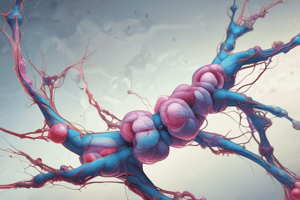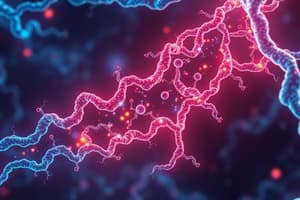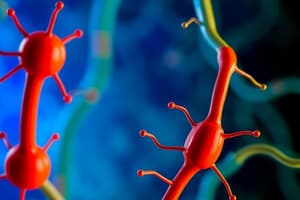Podcast
Questions and Answers
What is the primary function of ion channel-coupled receptors?
What is the primary function of ion channel-coupled receptors?
- To transport large molecules across the cell membrane.
- To provide structural support to the cell membrane.
- To facilitate the diffusion of water molecules into the cell.
- To enable rapid cellular response to external stimuli by altering ion permeability. (correct)
Which ions are most commonly associated with ion channel-coupled receptors?
Which ions are most commonly associated with ion channel-coupled receptors?
- Magnesium (Mg2+) and Phosphate (PO43-)
- Potassium (K+), Sodium (Na+), Chloride (Cl-), and Calcium (Ca2+) (correct)
- Copper (Cu2+) and Iodide (I-)
- Iron (Fe2+) and Zinc (Zn2+)
How does the binding of a ligand to an ion channel-coupled receptor typically initiate a cellular response?
How does the binding of a ligand to an ion channel-coupled receptor typically initiate a cellular response?
- It causes a conformational change in the receptor, opening or closing the ion channel. (correct)
- It directly activates intracellular enzymes.
- It triggers the synthesis of new proteins within the cell.
- It initiates DNA replication.
What structural feature is characteristic of the nicotinic acetylcholine receptor?
What structural feature is characteristic of the nicotinic acetylcholine receptor?
Which of the following is a key difference between ion channel-coupled receptors and voltage-gated ion channels?
Which of the following is a key difference between ion channel-coupled receptors and voltage-gated ion channels?
What is the primary effect of opening ion channels coupled to receptors on the electrical properties of a cell?
What is the primary effect of opening ion channels coupled to receptors on the electrical properties of a cell?
Where are ligand-binding sites typically located on ion channel-coupled receptors?
Where are ligand-binding sites typically located on ion channel-coupled receptors?
Which receptor has a trimeric structure?
Which receptor has a trimeric structure?
How do GPCRs (G protein-coupled receptors) modulate ion channel-coupled receptors?
How do GPCRs (G protein-coupled receptors) modulate ion channel-coupled receptors?
Which of the following is an example of a receptor that is modulated by GPCRs?
Which of the following is an example of a receptor that is modulated by GPCRs?
What distinguishes stretch-activated ion channels from ligand-gated ion channels?
What distinguishes stretch-activated ion channels from ligand-gated ion channels?
What is the immediate consequence of the opening of a ligand-gated ion channel?
What is the immediate consequence of the opening of a ligand-gated ion channel?
Why is the rapid signaling provided by ion channel-coupled receptors crucial in certain cell types?
Why is the rapid signaling provided by ion channel-coupled receptors crucial in certain cell types?
Which of the following describes the sequence of events in cell signaling via ion channel-coupled receptors?
Which of the following describes the sequence of events in cell signaling via ion channel-coupled receptors?
What is the function of the aqueous pore present in ion channel-coupled receptors?
What is the function of the aqueous pore present in ion channel-coupled receptors?
Which of the following structural classifications applies to the NMDA receptor?
Which of the following structural classifications applies to the NMDA receptor?
How does the activity of ion channel-coupled receptors directly contribute to rapid cell signaling?
How does the activity of ion channel-coupled receptors directly contribute to rapid cell signaling?
Why is it important for ligand-gated ion channels to be highly selective for specific ions?
Why is it important for ligand-gated ion channels to be highly selective for specific ions?
What causes the ion channel to remain closed in the absence of a signal molecule?
What causes the ion channel to remain closed in the absence of a signal molecule?
What is the function of an extracellular stimulus (ligand) in activating an ion channel-coupled receptor?
What is the function of an extracellular stimulus (ligand) in activating an ion channel-coupled receptor?
Flashcards
Ion-channel-coupled Receptor
Ion-channel-coupled Receptor
Membrane-spanning protein complex with an aqueous pore that opens upon ligand binding, enabling ion flow.
Activation of Ion Channel
Activation of Ion Channel
The binding of a ligand causes a conformational change in the receptor, opening the channel and allowing ions to pass through.
Importance of Ion Channels
Importance of Ion Channels
They facilitate rapid intracellular signaling in cells that need to quickly respond to a ligand.
Ligand
Ligand
Signup and view all the flashcards
Ion
Ion
Signup and view all the flashcards
Ligand-gated Ion Channel
Ligand-gated Ion Channel
Signup and view all the flashcards
Common Ion Channels
Common Ion Channels
Signup and view all the flashcards
Ligand Binding Site Location
Ligand Binding Site Location
Signup and view all the flashcards
Voltage-gated Ion Channels
Voltage-gated Ion Channels
Signup and view all the flashcards
Stretch-activated Ion Channels
Stretch-activated Ion Channels
Signup and view all the flashcards
Structure of Ach Receptor
Structure of Ach Receptor
Signup and view all the flashcards
Acetylcholine Receptor
Acetylcholine Receptor
Signup and view all the flashcards
GPCR Modulation of Ion Channels
GPCR Modulation of Ion Channels
Signup and view all the flashcards
Summary of Ion Channel Function
Summary of Ion Channel Function
Signup and view all the flashcards
Study Notes
Ion-Channel-Coupled Receptors
- These receptors are membrane-spanning protein complexes featuring an aqueous pore.
- In the absence of a signal, the channel stays closed.
- When a ligand binds, a conformational change occurs, opening the channel.
Ligand-Gated Ion Channels
- Ion-channel-coupled receptors are often located in cells needing a rapid response to a ligand.
- They are also known as ligand-gated ion channels or ionotropic receptors.
- An example includes the acetylcholine receptor at neurological synapses.
- Common ion channels include those for K+, Na+, Cl-, and Ca2+.
- Opening these channels leads to changes in a cell's electrical properties.
- Most ligand binding sites are within the receptor's extracellular domain.
- This enables cells to respond to external stimuli.
Distinctions
- Ion-channel-coupled receptors are distinct from voltage-gated ion channels, which depend on membrane potential differences.
- They are also different from stretch-activated ion channels, which rely on cell membrane deformations.
Structure of Ion Channel-Coupled Receptors
- These are transmembrane proteins.
- They have a pentameric structure consisting of α (2), β, γ, δ subunits as seen in the nicotinic acetylcholine receptor.
Receptor Types
- Pentameric receptors include those for Acetylcholine (Ach), GAMA, and glycine.
- Tetrameric receptors include AMPA, kainite, and NMDA receptors.
- Trimeric receptors include P2X receptors.
Examples
- N-methyl-D-aspartate receptor (NMDA) is permeable to ions (K+, Na+, Cl-, and Ca2+).
- Purinoreceptor (P2X) responds to ATP.
GPCR Modulation
- GPCR activation can alter the phosphorylation of ion channels.
- This can sensitize or desensitize the channels.
- It can also induce AChR and GABA receptor clustering.
Summary of Ion Channel-Coupled Receptors
- These receptors, also known as ligand-gated ion channels, respond to extracellular stimuli (ligands).
- Ligand binding causes a conformational change in the receptor.
- The opening of the receptor pore or channel allows ion movement.
- This alters the electrical charge of the cell, resulting in a local effect.
- This provides a rapid means of cell signaling.
Studying That Suits You
Use AI to generate personalized quizzes and flashcards to suit your learning preferences.




